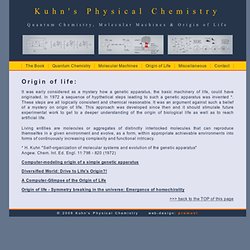

The Origin of Life Challenge. Post: July 27, 2012 12:34 am Author: Marlene Rosen Source: ETVOL Guest Contributor With the recent release of Prometheus, the media has asked again, what is the origin of life?

The movie questions if life on earth was created by aliens. With the use of Hollywood stunts and some black organic matter, the answer to this question is still the same as it has been: further investigation is necessary. Harry Lonsdale, a retired chemist, seeks to answer this question scientifically rather than fictionally. In mid- 2011 he proposed a challenge to the scientific community to come up with ideas to explain the mechanisms of life’s origin. Over 70 submissions were sent in, all competing for the offered reward of $50,000 and a potential $2,000,000 in research funding. Lonsdale threw in a couple of questions to help researchers formulate their ideas.
After learning about the Origin of Life Challenge, I was given the opportunity to interview Harry Lonsdale. HL: It started with this brochure I made. ASU Origins Project. The RNA world hypothesis: the worst theory of th... [Biol Direct. 2012. Origins of Life Through Organic Molecules. Origin of life: Hypothesis traces first protocells back to emergence of cell membrane bioenergetics. A coherent pathway -- which starts from no more than rocks, water and carbon dioxide and leads to the emergence of the strange bio-energetic properties of living cells -- has been traced for the first time in a major hypothesis paper in Cell this week.

At the origin of life the first protocells must have needed a vast amount of energy to drive their metabolism and replication, as enzymes that catalyse very specific reactions were yet to evolve. Most energy flux must have simply dissipated without use. So where did it all that energy come from on the early Earth, and how did it get focused into driving the organic chemistry required for life? The Origin of Life Challenge. Origin of Life Challenge: Strange life found in underwater caves - Biologists finding new microbes totally unknown elsewhere on Earth. Clues to how life evolved, not only on this planet but also possibly on alien worlds, might be found in underwater caves in the Bahamas, researchers say. The caves in question are called "blue holes," so-named because from the air, their entrances appear circular in shape, with different shades of blue water in and around them.
How Life Evolved on Earth, Alien Life Evolution. Clues to how life evolved, not only on this planet but also possibly on alien worlds, might be found in underwater caves in the Bahamas, researchers say.

The caves in question are called "blue holes," so-named because from the air, their entrances appear circular in shape, with different shades of blue water in and around them. There are estimated to be more than 1,000 such caves in the Bahamas, the greatest concentration of blue holes in the world. "It's really incredible to be swimming down a passage that no one has ever been in before, to experience that thrill of discovery," said researcher Tom Iliffe, a marine biologist at Texas A&M University at Galveston.
Strange Life Found in Underwater Caves. The Bahamas have more than 1,000 underwater caves, how many of them have their own unique ecosystem?

Microbiologists examined neighboring blue holes and were surprised to find a different set of microbes in each. Less than 5 percent of Earth's underwater cave systems have been scientifically investigated. Abiogenesis - EvoWiki. From EvoWiki The term abiogenesis simply means getting life from non-life and is used both for spontaneous generation and for chemical evolution.

While chemical evolution refers to the process by which the first living entities are thought to have appeared on a lifeless Earth, spontaneous generation refers to the, now discredited, theory that small animals and bacteria are spontaneously generated at the present time. Biological evolution Main article: Evolution is baseless without a theory of abiogenesis It is worth noting that creationists frequently confuse abiogenesis with evolution. Spontaneous generation The notion of spontaneous generation has had a long history, going back at least as far as Aristotle, and has often been regarded as self-evidently true.
However, some of van Helmont's contemporaries started becoming skeptical. "Concerning the generation of Froggs, we shall briefly deliver that account which observation hath taught us. Origins, Evolution, Extinctions « Science for the Public.
RNA World. Origins. Evolution, de l'origine de la vie aux origines de l'homme - CNRS. Evolution of life: home. <em>New Scientist</em> Weighs in on the Origin of Life. This week's issue of New Scientist contains an interesting article bearing the headline "First Life: The Search for the First Replicator.

" As a means to circumvent the chicken-and-egg problem pertinent to the relationship of DNA and proteins, author Michael Marshall attempts to revive the fashionable (but scientifically bankrupt) scenario of an RNA world. In brief, RNA exhibits both information-carrying capacity and catalytic activity. Arguments for the RNA world include the fact that RNA makes up a large proportion of ribosomes (the protein factory of the cell). Furthermore, in eukaryotes (organisms with nucleated cells), components of genes that don't code for proteins (called "introns") are spliced out of an RNA transcript before translation.
RNA molecules are involved in many of the RNA-splicing processes, and it has been documented that some RNA introns have self-splicing capability: that is to say, they can excise themselves, though at a slower rate than proteins can do so. Origins. By Lucas Laursen Charles Darwin may have had his biggest impact on biology, but he began his scientific career as a geologist.

So it’s appropriate that earlier this year, retired geologist John Ramsay, who had long studied the famed biologist’s life, accepted a commission to compose a Darwin-themed string quartet. Darwin “did some pretty fundamental geological mapping," says Ramsay, drawing a parallel to his own geological career, during which he has drawn maps of the Scottish Highlands, South Africa, and the Swiss Alps. Ramsay says he and Darwin also share a penchant for putting "ideas that spring from other parts of one's life" into their current work.
He notes that Darwin applied lessons from Earth's landscape to biology, adapting, for example, Charles Lyell's theory of gradual geological change to living things. Kuhn's Physical Chemistry. It was early considered as a mystery how a genetic apparatus, the basic machinery of life, could have originated.

In 1972 a sequence of hypthetical steps leading to such a genetic apparatus was invented *. These steps are all logically consistent and chemical reasonable. It was an argument against such a belief of a mystery on origin of life. This approach was developed since then and it should stimulate future experimental work to get to a deeper understanding of the origin of biological life as well as to reach artificial life. Living entities are molecules or aggregates of distinctly interlocked molecules that can reproduce themselfes in a given environment and evolve, as a form, within appropriate achievable environments into forms of continuously increasing complexity and functional intricacy. * H.
NASA Astrobiology. New Evidence Challenges Oldest Signs of Life. Carbon found within ancient rocks has played a crucial role developing a time line for the emergence of biological life on the planet billions of years ago.

But applying cutting-edge technology to samples of ancient rocks from northern Canada has revealed the carbon-based minerals may be much younger than the rock they inhabit, a team of researchers report in the latest edition of the journal Nature Geoscience. The team – which includes researchers from Boston College, the Carnegie Institution of Washington, NASA's Johnson Space Center and the Naval Research Laboratory – says new evidence from Canada's Hudson Bay region shows carbonaceous particles are millions of years younger than the rock in which they're found, pointing to the likelihood that the carbon was mixed in with the metamorphic rock later than the rock's earliest formation – estimated to be 3.8 to 4.2 billion years ago.
The New York Center for Astrobiology at Rensselaer Polytechnic Institute. Origins: Astrobiology: The Search for Life. Szostak Lab: Home. We are interested in the chemical and physical processes that facilitated the transition from chemical evolution to biological evolution on the early earth. As a way of exploring these processes, our laboratory is trying to build a synthetic cellular system that undergoes Darwinian evolution. Our view of what such a chemical system would look like centers on a model of a primitive cell, or protocell, that consists of two main components: a self-replicating genetic polymer and a self-replicating membrane boundary. The job of the genetic polymer is to carry information in a way that allows for both replication and variation, so that new sequences that encode useful functions can be inherited and can further evolve.
Exploring Life's Origins: A Virtual Exhibit.